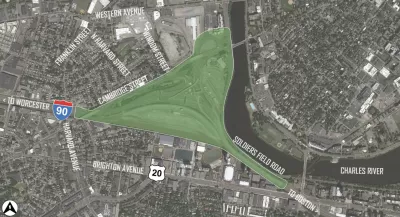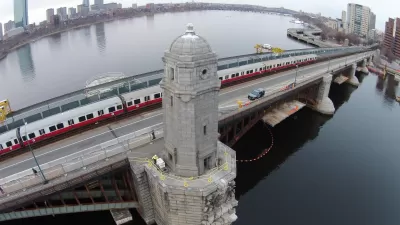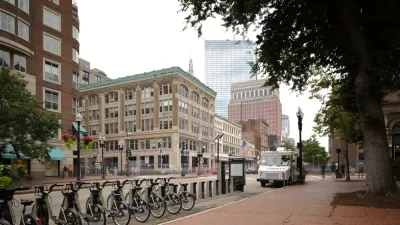Massachusetts Department of Transportation plans to heighten and widen the Allston section of I-90 viaduct do not align with the community's desire for an environmentally friendly and pedestrian- and cycling-oriented new solution.

The Allston section of I-90, a stretch of viaduct wedged between Boston University and the Charles River, was opened 55 years ago. The highway constitution project bisected a lower-income community and damaged riverfront habitat. Boston, Brookline, and Cambridge are still paying the price for what Bradley Campbell and Richard Dimino call "failed transportation policy that placed a highway above the needs of neighborhoods and the environment."
Now the viaduct needs to be replaced. "Nearly all stakeholders, including the city of Boston, agree that we should pursue a strategy for I-90 that plans for our future transportation needs, not reprise last-century’s failed approaches to create a new, bigger viaduct," write Campbell and Dimino.
Still, MassDOT's “Modified Highway Viaduct” option takes that very approach, heightening and widening the viaduct.
Campbell and Dimino stress that better options exist. A Better City, led by Dimino, has proposed an at-grade design that adds trees and a living shoreline to the pedestrian and bike access space running along the river. "This improved surface option is also designed to ensure that two-track commuter rail service on the Worcester Line remains in service during construction," they say.
Governor Charlie Barker should step up and give "Boston and the region a western gateway equal to its aspirations as a leader in urban design, transportation vision, and environmental planning," Campbell and Dimino assert.
FULL STORY: A new, bigger I-90 viaduct is not the answer

Alabama: Trump Terminates Settlements for Black Communities Harmed By Raw Sewage
Trump deemed the landmark civil rights agreement “illegal DEI and environmental justice policy.”

Planetizen Federal Action Tracker
A weekly monitor of how Trump’s orders and actions are impacting planners and planning in America.

The 120 Year Old Tiny Home Villages That Sheltered San Francisco’s Earthquake Refugees
More than a century ago, San Francisco mobilized to house thousands of residents displaced by the 1906 earthquake. Could their strategy offer a model for the present?

In Both Crashes and Crime, Public Transportation is Far Safer than Driving
Contrary to popular assumptions, public transportation has far lower crash and crime rates than automobile travel. For safer communities, improve and encourage transit travel.

Report: Zoning Reforms Should Complement Nashville’s Ambitious Transit Plan
Without reform, restrictive zoning codes will limit the impact of the city’s planned transit expansion and could exclude some of the residents who depend on transit the most.

Judge Orders Release of Frozen IRA, IIJA Funding
The decision is a victory for environmental groups who charged that freezing funds for critical infrastructure and disaster response programs caused “real and irreparable harm” to communities.
Urban Design for Planners 1: Software Tools
This six-course series explores essential urban design concepts using open source software and equips planners with the tools they need to participate fully in the urban design process.
Planning for Universal Design
Learn the tools for implementing Universal Design in planning regulations.
Clanton & Associates, Inc.
Jessamine County Fiscal Court
Institute for Housing and Urban Development Studies (IHS)
City of Grandview
Harvard GSD Executive Education
Toledo-Lucas County Plan Commissions
Salt Lake City
NYU Wagner Graduate School of Public Service




























